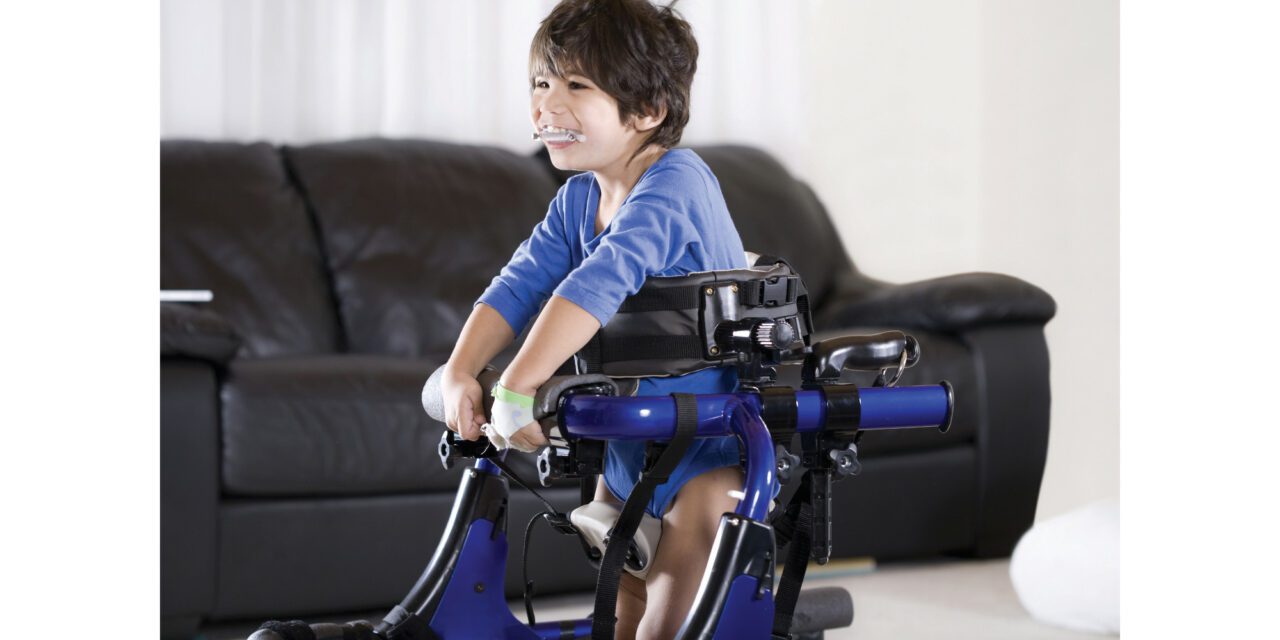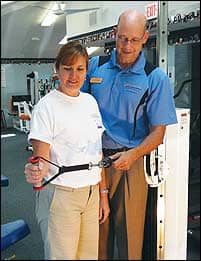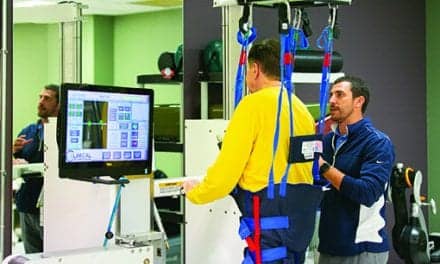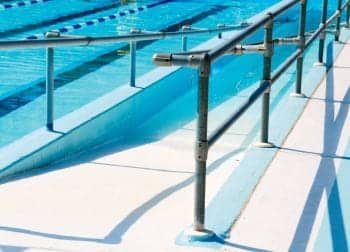Photo Caption: When a child is more dependent, support walkers are a great option to increase their independence. These assistive devices are available in different sizes with steering, seating, and other accessories to make them more appealing for the child to use. Photo: Dreamstime
by Alaena McCool, MS, OTR/L, CPAM
Who Should be Considered for Assistive Devices?
Any child with a medical diagnosis that impedes gross motor development or ability across the lifespan is an appropriate candidate for an assistive device to improve mobility. Although research has noted that children at the average age of 2.5 are recommended for devices, there is limited available research before that age.1 A device may be appropriate at the recommendation and monitoring by a qualified physical therapist, occupational therapist, or another medical practitioner.
Assisting the Development Process
Mobility affects each stage of childhood differently. In the infancy and toddler phase, a period of rapid growth occurs focusing on gross motor, fine motor, cognitive, and social development. Infants and toddlers develop and acquire new skills through exploration of the environment using their own body and senses. In this stage, the young child is moving from rolling, crawling, and advancing to walking. In each phase, the child is learning how to interact with that environment differently. Per Piek, motor abilities may be a prerequisite for other development such as cognition.2
When children can roll, they develop their eyesight for more detail in discerning who people are and what objects look like. As children walk, they are learning to interact with their family, learning from facial expressions and gestures.
However, as a child grows and matures through adolescence and young adulthood, more emphasis is put on being independent to participate and engage in ADLs and IADLs, engaging with peers during school and leisure activities, and participating in age-appropriate hobbies. Giving that child independence in mobility through assistive devices allows for interaction and engagement to improve their quality of life and to increase peer and family interaction, their ability to learn obstacles, and an overall participation in typical age-appropriate development and activities, including play.
Early intervention in a child’s impairment or diagnosis is critical to allowing them to begin to learn and use a mobility device to increase the independence needed in their current stage of childhood. Young children with mobility impairments may display passive behaviors with decreased curiosity, initiation, and motivation when not encouraged to ambulate or explore their environment. This can lead to a “learned helplessness” which has a child learn to give up control of their own environment. This learned helplessness can progress into adulthood, which can contribute to detrimental consequences when attempting to enter higher-level education or work training.3
Children with disabilities, particularly those with severe motor impairments, typically participate in less physical activity and exhibit more sedentary behavior than their typically developing peers.1 Mobility devices are imperative to encourage movement that allows for exploration and overall independence in one’s current stage of life.
Types of Assistive Devices
There is an array of options of mobility devices that are less restrictive as compared to a wheelchair. These include crutches, walkers, and support or gait trainers. Crutches and traditional handheld walkers are common to promote independent locomotion, easier for storage, more common in society, and easier to navigate obstacles. Nevertheless, these devices may not be feasible for a child with a more severe disability or inability to stand upright.
When a child is more dependent, support walkers are a great option to increase independence. These are defined as “any device that permits mobility for children who require more support than provided by handheld walkers, including some level of trunk, pelvic, and/or head support.”1 Support walkers, which also may be known as rollators or gait trainers, are available in different sizes with steering, seating, and other accessories to make them more appealing for the child to use. Attachments include a seat or pelvic sling, an abductor pommel, anti-scissoring systems, forearm supports, trunk supports, suspended strapping to unweight the child, and handles or grab bars.4
Support walkers are designed to allow children to interact with their peers and participate in activities in the school and home settings.4 Although a great option to increase independence, some children with poor upright stability may require significant assistance to get into this device and overall may need additional training in the environments where the child is planning to use the device. A qualified vendor can provide options that are recommended by the referring therapist or medical provider.
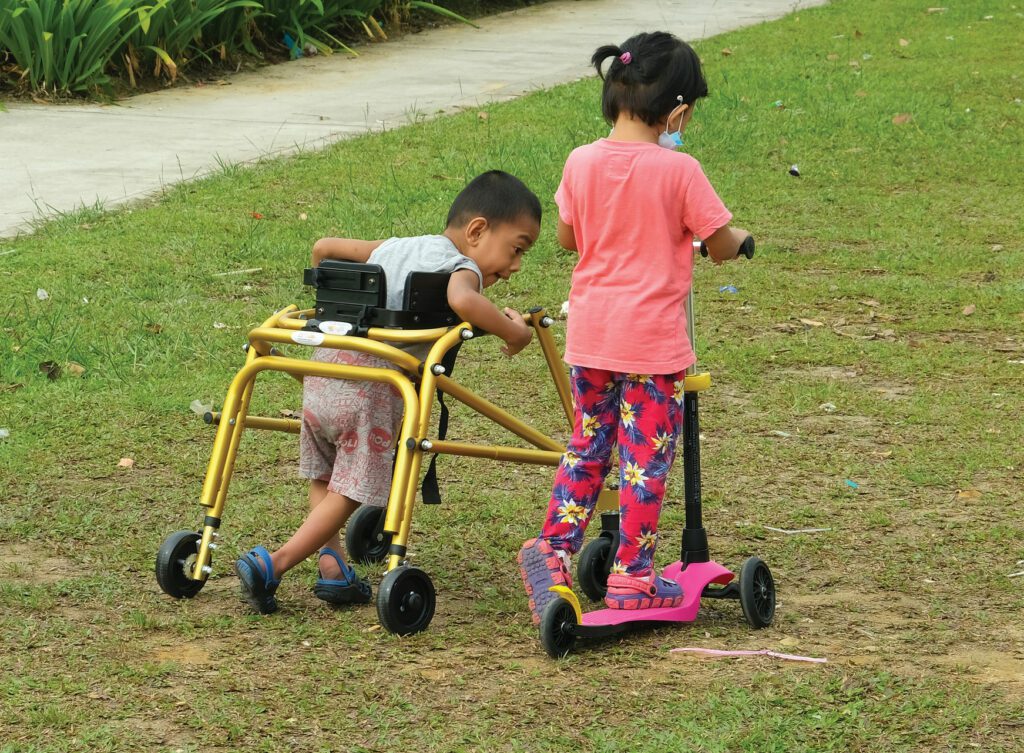
Other Considerations
Sizing may become an issue when recommending devices for a young child, but a skilled physical therapist is able to trial the device with adaptations as appropriate and make recommendations as the child grows into the device.
Children may also benefit from more than one device. It may be better for a child to use a less restrictive device like a walker at home or in a familiar environment compared to a new environment such as a new school, a friend’s house, or even a park where a manual or power wheelchair may be more appropriate. Each plan is specific to the child, the child’s engagement in the environment, age level, progression of disease, financial ability and insurance coverage, and family support. When selecting a vendor, therapists will be able to provide options of brands and confirm insurance coverage to ensure the patient and family are given the most optimal piece(s) of equipment.
Initiating the Conversation
A qualified physical or occupational therapist, medical provider, or a seating team specialist is appropriate to recommend the type of assistive device. Once the therapist and/or team have a clear picture of the child’s age, developmental abilities, and current level of function, a discussion can be initiated with the child and family to educate about the benefits of using a device, possible options of mobility devices, and trialing devices during clinic time.
The team also needs to be aware of the patient and family’s current level of coping. Although the actual deficit is affecting the patient in their own daily life, a parent or caregiver may also be experiencing sadness over the child’s disability or difficulties. Introducing mobility devices to one’s child may also include psychosocial barriers of stigma and negative attitudes within society. The therapists’ job is to provide the most up-to-date research, educate the family on the device, and give any information the family requests. Social work is also a great resource for families who are in the early stages of coping with this situation, especially if this can be made available in a clinic.
Evaluation
When the child and parent or caregivers are ready, the therapist can initiate trialing different mobility options and begin the first phase of learning. Selecting a device is unique for each individual and may take multiple trials before finding one that works for that patient.
Considerations again should include diagnosis and prognosis, age, upper and lower extremity function, trunk and core strength, any range of motion limitations, child’s engagement or goal of engagement in various environments, child and patient goals, and caregiver support in each environment. The physical and/or occupational therapists can work together to ensure the child is set up optimally to encourage proper body mechanics, including hip, leg, and arm position.
The goal of the team is to get the child into a device that allows for more independence in all environments at that current moment in time. This may require that the child wear certain orthotics, including leg, arm, and/or trunk orthoses. If the team determines any of these are needed, a referral to an orthotic specialist can be made at that time. The vendor should also be able to discuss options that are covered by insurance and when a new device will be able to be obtained once the child outgrows the one selected.
Education and Training
Throughout training and trialing of devices, education is provided to the family about benefits of the device; getting the child in, set up, and out of the device; frequency of use of device; appropriate environments in which to use the device; and answering any additional questions throughout training. The therapist creates a safe and familiar environment that allows the child time to process, explore, and problem-solve obstacles.
Depending on the child’s age, encouragement such as clapping from caregivers and the therapist may be important to provide motivation.3 Other ways to keep the child motivated may include inviting siblings to the clinic to engage with them, or having the child engage with other children in the clinic to encourage more socialization and positive association while using the device.
Each environment has its own barriers and must be considered, as well as the amount of support available from caregivers. The challenges are different for each individual, including distances that need to be covered, objects in place producing new obstacles, and time constraints that assist in helping the child keep up with their peers and family within that environment.
Pediatric Assistive Devices Offer Longterm Benefits
The overall benefits of a child being able to ambulate include independence in participating in ADLs, IADLs, and community tasks, as well as other social functions. An assistive device is beneficial to allow a child to explore, learn, and play in their own environment and continue to grow, interact, and develop alongside their peers. Providing education and training to ensure the patient and family are set up for success in multiple environments will allow the child to live a more full and engaging life.
Alaena McCool, MS, OTR/L, CPAM, has been an occupational therapist at Kennedy Krieger Institute within the International Center for Spinal Cord Injury (ICSCI) in Baltimore since 2018. She received her Bachelor of Arts in Communication Science from University of Pittsburgh in 2011, followed by her Master of Science in Occupational Therapy from New York University in 2015. Her current clinical interests include pediatrics, behavioral management, and the neurologically impaired upper extremity. For more information, contact [email protected].
References
1. George C, Levin W, Ryan JM. The use and perception of support walkers for children with disabilities: a United Kingdom survey. _BMC Pediatr_. 2020;20(1):528. Published 2020 Nov 18. doi:10.1186/s12887-020-02401-5
2. Piek JP, Dawson L, Smith LM, Gasson N. The role of early fine and gross motor development on later motor and cognitive ability. _Hum Mov Sci_. 2008;27(5):668-681. doi:10.1016/j.humov.2007.11.002
3. Huang HH. Perspectives on early power mobility training, motivation, and social participation in young children with motor disabilities. _Front Psychol_. 2018;8:2330. Published 2018 Jan 9. doi:10.3389/fpsyg.2017.02330
4. Low SA, McCoy SW, Beling J, Adams J. Pediatric physical therapists’ use of support walkers for children with disabilities: a nationwide survey. _Pediatr Phys Ther_. 2011;23(4):381-389. doi:10.1097/PEP.0b013e318235257c
Related:

